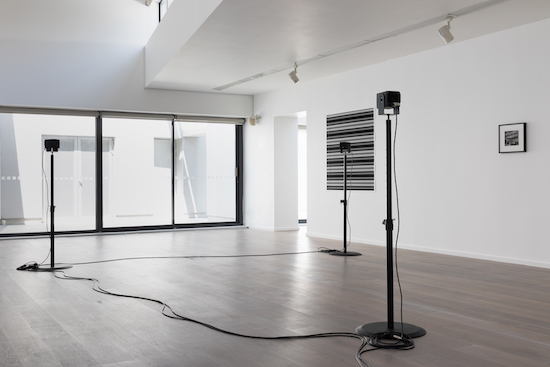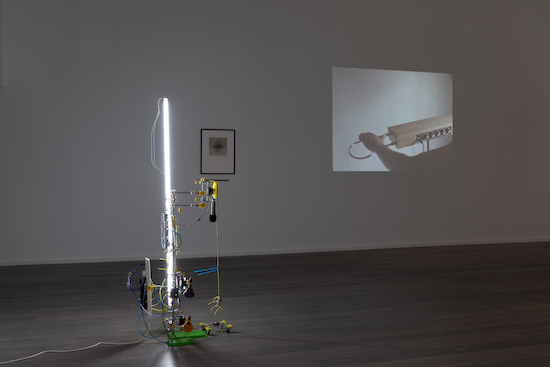“In my music, you have to concentrate on one or two things … one thing actually. I’ve been told that listening to it is paying attention to how you’re listening. It’s contemplative.” This succinct stylistic overview was delivered by Alvin Lucier during a visit to Ireland in 2014. Close to 5,000km away from his Connecticut home, the American composer had been invited by Louth Contemporary Musical Society to perform his seminal piece, I Am Sitting in a Room (1969) in The Oriel Centre located on the grounds of the former Dundalk Gaol.
This special performance was part of an event called Sounds in Space. Apt given that the relationship between sound and surroundings is crucial to Lucier’s artistic statement with this particular piece. I Am Sitting in a Room, a recording in which Lucier articulates (and repeats) a text outlining the conditions of his demonstration and what he aims to achieve over its forty-one minute duration. “I am recording the sound of my speaking voice and I am going to play it back into the room again and again until the resonant frequencies of the room reinforce themselves so that any semblance of my speech, with perhaps the exception of rhythm, is destroyed,” Lucier intones in the 1969 sound art piece. “What you will hear, then, are the natural resonant frequencies of the room articulated by speech.” In parts, he stutters. In the final movement (as it were) of the recording, the resonant frequencies in the room have usurped the narration, transforming the timbre of Lucier’s voice into an abstract (and enveloping) drone.
About an hour’s drive from where Lucier performed his infamous composition almost a decade ago in rural Ireland, is the Solstice Arts Centre in Navan, Co. Meath. Since mid-June, the centre has hosted an exhibition taking its name from Lucier’s work. Curated by Belinda Quirke, I am Sitting in a Room features the works of five artists, each one presenting different perspectives on sound frequency and environment. Contained within the gallery’s upper floor are three separate spaces with vastly impressive conceptual pieces that command the fullest attention of the observer. Immersive in its essence, the central message of the exhibition effectively enlightens the spectator of the omnipresence of sound as well as re-contextualising its role in everyday settings. Some of the pieces require incisive listening. Whilst roaming the space, part of the fun is trying to decipher the origins of certain resonating drones and whether what you’re listening out for is part of the show or an inherent element of the room itself.

The main body of the exhibit begins with Sven Anderson’s This Voice, specially commissioned by the Office of Public Works (OPW). Three speakers in the centre of the room, each emitting sound passages of recordings of singers performing at opera houses on 78s which create an eerie atmosphere in the spacious room. On the surrounding walls are liner notes acquired from the Derek Hill Collection, the source of the recordings incorporated into Anderson’s work. The liner notes give fascinating insights into the lives and careers of four revered sopranos: Meta Seinemeyer, Salomea Kruscenski, Bidu Sayao, and Ellen Beach Yaw. The typed document concerning the latter reveals information that feels fitting to the exhibition as a whole: “From the time she was a child, she sang much out of doors, showing preference for settings where her voice could echo.” Sensory trickery taunts the spectator in Anderson’s section. When examining the four large-scale prints (each using a portrait of an opera singer to create intricate geometric sequences) which accompany the audio aspect of Anderson’s work, it’s easy to be drawn closer to a nearby speaker. Similarly, the striking prints invite the spectator to experience the work from different vantage points to unlock hidden patterns within.
Bridged between the first and final sections of the exhibition is Karl Burke’s site specific installation, Convergence. Comprised of floor to ceiling panels painted black on one side with speakers sending out modular synth waves facing the imposing structures and not the spectators. Exploring this section, you almost feel like Alice investigating an extremely minimal and monochromatic wonderland. In fact, much of the work included in I am Sitting in a Room conjures this feeling. This is heightened even more by the fact that the artists have timed their installations in a loose sequence for the benefit of the visitor navigating the works. From there, Adam Gibney’s digital and physical media piece Spatial Meditation 4: Silencing Silence introduces colour and corporeality to the exhibition. Its structure, adorned with bright cables and bells and instantly attracting the eye with a vertical light feature, is completely captivating. The noises created by the mechanics of the structure as it operates a dangling microphone which rhythmically produces feedback that sets off what could be interpreted as either a shrill hiss or soothing “ssssh” are strangely hypnotic.

A huge part of the exhibition’s allure (aside from the artworks themselves) is the level of mystery and intrigue permeating the space. What are we supposed to receive, as it were, from the various mixed media pieces, photographs, canvases and impressive installations? Being confronted by the works encourages heightened sensory concentration: what are we seeing, what are we listening out for? One of the more illuminating pieces that unlocks some of the concepts underpinning the exhibition is Chloe Brenan’s insightful Super 8mm film, Different Dusts. Utilising the theremin, the haunting electronic instrument operated without physical contact, spliced with footage of ancient Irish stone statues and scenes from nature, Brenan highlights the role of elements in the atmosphere and temperature from the human body and the effect they can have on frequencies and natural material such as stone. A body leaps into a pond, the water ripples mimicking the appearance of soundwaves. This particular image coupled with Theo McNab’s geometric studies produced between 1972 and 1976 of light and sound waves are reminders of the scientific and natural potential of music – frequencies and resonances – to exist in a manner of everyday occurrences. I am Sitting in a Room ultimately inspires a deeper evaluation and heightened awareness of the sounds that fill the air and space around us. It’s an exercise in concentrated listening that will alter how you hear the world around you.
I am Sitting in a Room is at The Solstice Arts Centre, Ireland, until 5 August 2022


